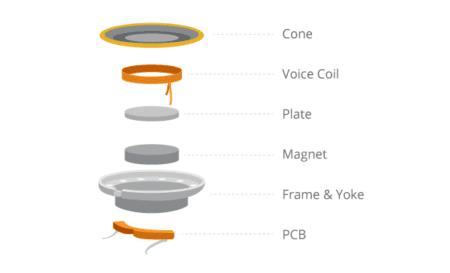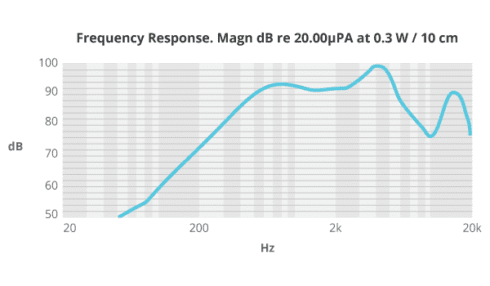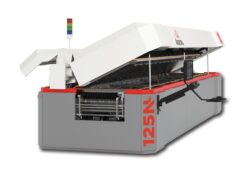Welcome to the CUI Product Spotlight on speakers. Learn about CUI Inc’s speaker product offerings, including a description of speaker theory and its working principles, along with key specifications and applications.
Objectives
- Introduce speaker structure
- Introduce speaker working principles
- Define common specifications
- Introduce various options among CUI’s speaker line, including magnet types, cone types, and mounting configurations
- Introduce typical applications
Speaker Structure
Shown here is an illustration that highlights speaker structure and breaks down the individual components of a typical speaker.

Speaker Structure Continued
The illustration shown here highlights the structure of a typical speaker after all of the components have been assembled.

Working Principle of Speakers
Sound is produced from a speaker by sending a varying signal to the voice coil causing it to vibrate. The signal comes in the form of a voltage that is switching back and forth between positive and negative hundreds to thousands of times per second.
The signal voltage induces a current in the voice coil, creating an electromagnetic field, with a North and a South pole. When the voltage, and thereby current is switched, so will the magnetic poles. The magnet attached to the frame is a permanent magnet with a constant magnetic field. When the magnetism of the voice coil and permanent magnet are alike the voice coil will be repelled, and when the fields are different the voice coil will be attracted to the permanent magnet. Because the voltage alternates many times per second the voice coil will move up and down very rapidly.
The upward and downward movement of the voice coil makes the speaker’s cone vibrate, thus causing the surrounding air molecules to vibrate which we hear as sound.
Key Speaker Specifications
Sound Pressure Level (dB) – Sound pressure level, SPL, is the deviation from atmospheric pressure caused by the sound wave expressed in decibels.
Max Input (W) – Maximum power that can be used for a very short period of time without permanently damaging the speaker.
Nominal Input (W) – The nominal input wattage is the amount of power the speaker can safely handle during long-term use.
Impedance (Ohm) – Electrical impedance is the ratio of applied voltage to current. It is important to match the speaker impedance to the system impedance.
Resonant Frequency (Hz) – It is the frequency at which the electrical impedance of the speaker is at its maximum and is affected by both the electrical and mechanical design of the speaker. Resonant frequency specifications provide a means to approximately compare the low frequency response of different speakers.
Size (mm) – Frequency range is determined by the size of the speaker. Smaller speakers will operate optimally at higher frequencies, while larger speakers operate more optimally at lower frequency ranges. Low frequencies are used for deep bass sounds, while mid-range frequencies are used for voice reproductions.
Frequency Response Curves
For speakers, the word “respond” represents the speaker’s ability to recreate the input frequencies.
When this data is plotted, it forms a frequency response graph that provides a visual representation of amplitude over frequency generated by the speaker. The vertical axis is labeled as the level of sound in decibels (dB) and the horizontal axis is labeled as the frequency in Hertz (Hz).
- A perfect speaker would recreate every frequency without attenuation or gain. There is no perfect speaker.
- The frequency response curve is a series of data points that represents how a speaker responds to a range of input frequencies.

dB’s
Lp = 10log10 (Prms/Pref) = 20log10 (Vrms/Vref)
A decibel is the scaled logarithm of the ratio of a measured value with respect to a reference value. Decibels are useful because they can show a huge range of values in a small space. For instance a sound pressure scale going from 0-120 dB can represent sound pressures from 20 µPa (micro-pascals) to 20,000,000,000,000 µPa. This roughly represents the lowest SPL a human can hear all the way up to uncomfortably loud sounds. The generally accepted value for “Pref” in the formula shown here is 20 µPa.
- dB stands for decibel
- It is not a unit, but rather a ratio
- Values increase exponentially, instead of linearly as in counting numbers
- Expressed in “normal” numbers, 2 dB is ten times 1 dB
- Allows for a huge range of values to be expressed in relatively little space
The Human Ear and A-Weighting
| Comparison of Different SPL’s | ||
| Jet engine at 30 m | 632 Pa | 150 dB |
| Threshold of pain | 63.2 Pa | 130 dB |
| Hearing damage (possible) | 20 Pa | Approx. 120 dB |
| Jet at 100 m | 6.32-200 Pa | 110-140 dB |
| Jack hammer at 1 m | 2 Pa | Approx. 100 dB |
| Traffic on a busy roadway at 10 m | 2×10-1-6.32×10-1 Pa | 80-90 dB |
| Passenger car at 10 m | 2×10-2-210-1 Pa | 60-80 dB |
| Normal conversation at 1 m | 2×10-3-2×10-2 Pa | 40-60 dB |
| Very calm room | 2×10-4-6.32×10-4 Pa | 20-30 dB |
| Auditory threshold at 1 kHz | 2×10-5 Pa (RMS) | 0 dB |
The 20 Hz to 20 kHz range tends to be the general range for human ears. This range is reduced with age, especially in males. In older males 13 kHz tends to be the upper end of the audible range. The human ear does not have a flat frequency response over the audible range. Certain frequencies tend to be attenuated while others are magnified. A-weighting attempts to compensate for this by discounting frequencies which the human ear is less sensitive to. It places priority on sounds between 1 kHz and 7 kHz. Some CUI speakers specify SPL using the A-weight system. I.E. dB A.
SPL Calculator
CUI has developed an SPL calculator to allow users to convert a speaker’s specified SPL on the datasheet to different real-world conditions, or to compare SPLs between two devices with different specified parameters. This tool makes it quick and easy for designers to specify the proper speaker for their application.
Magnet Types
Listed are the three most common magnet types used in speakers today.
Ferrite
Ferrite magnets, also called ceramic magnets, are low cost magnets that maintain their magnetic strength well. They are heavy and are not generally used for applications that require portability. Speakers that incorporate ferrite magnets will tend to sound better when driven near the maximum handling capacity.
AlNiCo
AlNiCo magnets were the first magnets used in speakers and are what helped give them a smooth tone. Speakers that incorporate AlNiCo magnets are a more expensive option than ferrite-based speakers, but they are less prone to cracking.
Neodymium (NdFeB)
Neodymium magnets, also known as rare earth magnets, offer the highest field strength of any permanent magnet known. Speakers made with NdFeB magnets offer a good frequency response, are light in weight and are much smaller than speakers that incorporate ferrite or AlNiCo magnets. This makes them an ideal magnet for small speakers that are required to output a high SPL.
Cone Types
Listed are the three most common cone types used in speakers today.
Paper and Cloth
Paper and cloth cones offer excellent sound quality and are good at self-damping. However, they can be susceptible to environmental factors such as humidity that could degrade sound quality.
Mylar (plastic)
Mylar is commonly used for speakers requiring resistance to environmental factors or an IP rating for immunity to dust or water. The ease in maintaining tight tolerances during the manufacturing process also makes speakers with Mylar cones attractive.
Sound Quality
The choice of cone material along with other properties of the speakers will affect the sound quality and is often best determined by subjective testing rather than quantitative analysis.
Speaker Size and Shape
In general, speakers with larger surface areas will produce greater sound levels for the same drive signal and will also have better low frequency response. The performance of smaller speakers can be greatly enhanced using DSP pre-distortion; this technique is often incorporated in cell phone and laptop computer designs. A small amount of performance enhancement can be achieved with the design of the enclosure surrounding the back of the speaker.
The shape of the speaker cone is often determined by the available installation space. An oval shaped speaker cone allows a greater speaker cone surface area to be fit into a non-square space. The frequency response graph of the speaker should be examined to determine if the size or shape of the speaker is adversely affecting the desired performance of the speaker.
Connection Configurations
CUI’s speakers are also available in various connection configurations depending on the application need, including solder eyelets, solder pads, solder pin/posts and wire leads.
Applications
Speakers are used in a wide variety of products and industries to accurately reproduce voice, music, and various other audio signals. The major application categories that utilize speakers include: consumer products, home appliances, automotive electronics, medical, safety and security, industrial, and office automation.
https://www.cui.com/product-spotlight/speakers?utm_source=CUI










